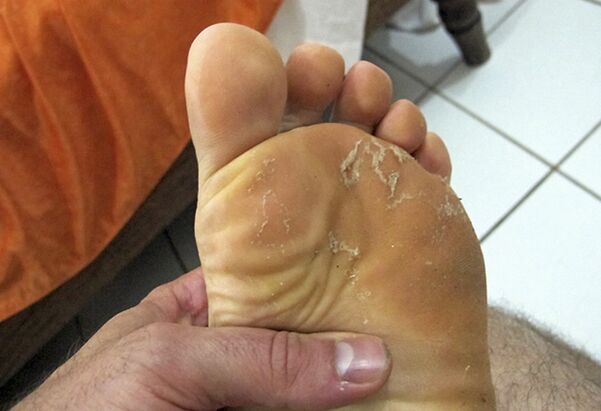
Feat fungus is a common disease that belongs to a dermatomicosis group and develops due to the activation of pathogenic microorganisms.
Causal Agents Mikoza live in plants and soil, on the body, in the body, in the body of animals and retain their lives, are in shoes or clothing infected, so everyone can infect fungal infection.
What is mycosa's feet?
Foot fungal is a disease caused by pathogenic microscopic fungi, which is a skin lesion of interdigital gaps with further expansion of infection to a healthy body surface.
This pathology can be manifested at any agebut especially often disease is diagnosed in older people and people with impaired immunity.
About 50 types of mushrooms that exist in nature is a potential danger.Under the influence of favorable conditions, they are all capable of a parasite on the human body and within it, provoking the development of systemic and local fungal pathology.
Important!
Fungling lesion of the foot causes a change in the structure of the skin and, in the absence of timely treatment, separation of nail plates.
Mkb code 10
According to the ICD-10, Mikoz Stop has a code B35.3.
Varieties of fungal skin diseases
Experts vary several main types of mycosis foot depending on the pathogen.Each variety has its own characteristicsAnd continues with a number of unpleasant symptoms.
Rubrofitius
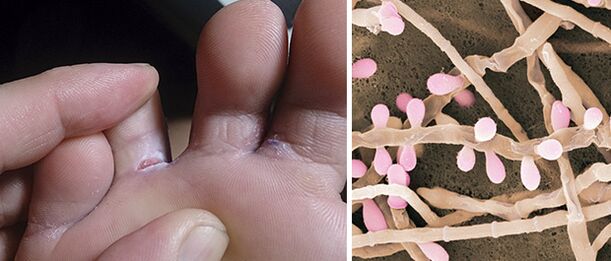
The cause isTrichophyte Rubrum Fungi.The clinical picture of pathology begins with the fact that the disease covers the feet and folds between the fingers, however, in the process there is an infection through the body with lymphemematogenic expansion of external protein structures.
Candidiasis of the station
Develops due to penetration in the human bodyMushrooms Roda Candida.The stopkeeper's candidia begins with a lying interdigital spaces and nails.At the same time, the area roller area becomes hyputemic and ememoidal, and the patient may be disturbed by pulsating pain in the damage zone and difficult itches.
Onyhycosis
Damage to nail tiles caused by dermatophytes, fungiType of candidate or mold.The fungi is unpretentious for the terms of existence and characterize it with high life resistance, so that with an advanced form of disease is difficult to treat.
Intriginal (interdigital) form
The most preferred form of mycosis, which is determined by the harm interdigital folds without the emergence of the signs of the pathological process on the foot.As the patient develops, cracks, peeling, erythema and maceration appear.In the future, against the background of the disease, each bacterial infection can be developed.
A numbin -hyperkeratotic form
It is characterized by simultaneous damage to both legs.The disease continues with strong peeling and keratinization of infected areas of the skin, as well as with the occurrence of deep cracks in the affected areas.Itching is insignificant or absent.
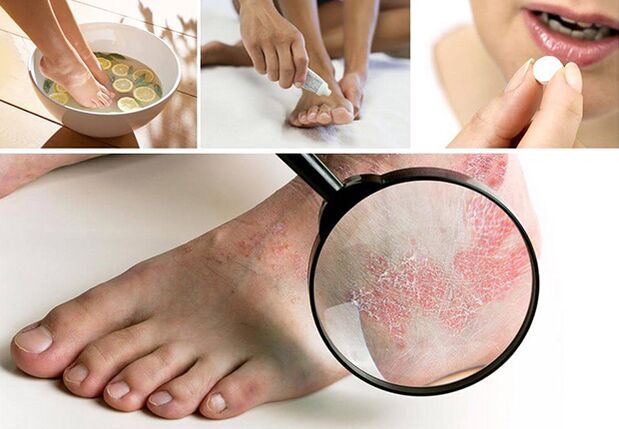
Dyshidrotski shape
Once the infection penetrates the body, in the patient's skin, hyperemia and kidnomena increase in a lot of bubbles with a rough surface, which is a dishuffle disease similar to the eczema.After rupture, bubbles form erosion zonesOn the fifth or rising of the foot.
Deleted form
Different Micosa has minimal clinical manifestations in the form of inconspicuous microcracks in interdigital folds of the skin and bowling.The patient does not experience discomfort, which is why the treatment of pathology is delayed for a long time.
Madur foot
Long, deep micosa, which affects mainly legs.The disease begins with focal inflammation in subcutaneous tissue and gradually spreads to soft tissues, internal organs and bones.
In the initial phase pathology does not manifestBut then the seal with a pure content and a certain scent forms at the foot of the infected.The surface of the skin becomes damaged and reminded of the turtle shell.
Stage phases of stops
The period of incubation of the Micoso stop is 3-14 days, after which the infected person manifests the first signs of infection.Dermatologists attract patients' attention to the fact that the disease has several stages of development.
Initial
Patient cannot doubt the infection as well as the initialThe phase of mycosis is understood as ordinary dry skin.Cracks and redness appear on the foot.There is a little swelling and itching.
Average
In the middle phase of fungi, it is identified without difficulty, because large pink stains appear on the skin, the surface of the peels increases and itching increases.
Neglected
The fungus also affects the foot with interdigital places and nail plates.Nails become fragile and fragile, start decaying and sprinkling.The skin is rough, compact, covered with deep cracks and separated by large layers.
Causes and symptoms of fungal damage
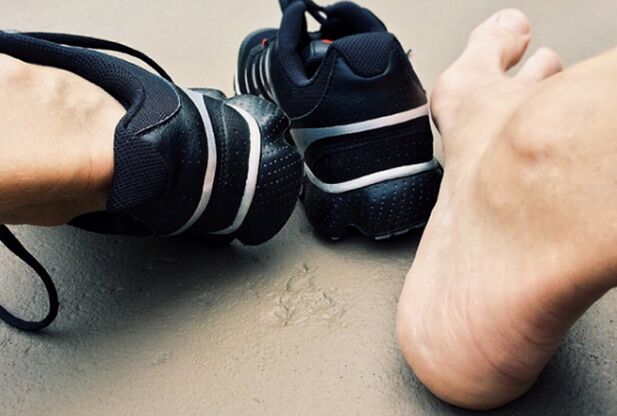
If a person is completely healthy, after direct contact with the source or bracket of infection, his personal belongings or household facilities, the infection cannot appear.However, in case any disorders are present in the body, there is a great risk of infection.
They become factors provoking:
- Famiage of protective functions;
- increased sweating or dry skin;
- extended medications;
- non-complications with hygienic rules;
- Violation of circulation;
- Presence of microdamine on the skin;
- Excess weight;
- Foot deformation;
- Wearing tight shoes.
Depending on the localization of inflammation and form of illness, a fungal infection can be accompanied by the following symptoms:
- light or strong redness of the skin on a lesion;
- Itching and ignition;
- skin peeling;
- Change nail color;
- the occurrence of small cracks;
- Loading and thickening of foot skin;
- Rashble rash;
- An unpleasant odor.
Diagnostics
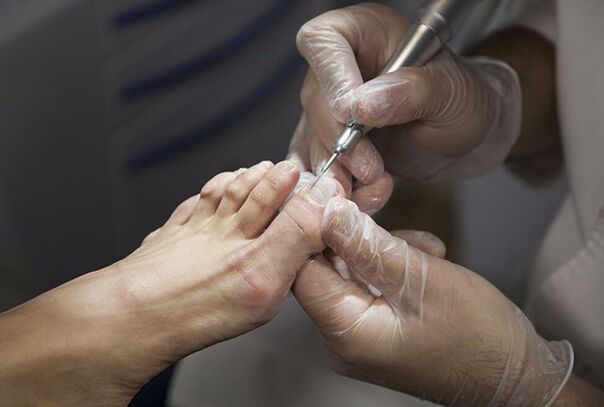
The diagnosis of fungal leg diseases makes a mycologist and a dermatologist, who should be contacted immediately after the occurrence of one or more symptoms of pathology.
The specialist will be able to identify the presence of infection during the initial review, but it will not be possible to establish the type of pathogen without additional laboratory tests.
Determination of the type of fungus is done with:
- General and biochemical blood test;
- scraping from the affected leather area;
- Sowing the collected material for a nutrient;
- Skin biopsy;
- Special test for confirmation of the presence of infection in the body.
Based on the obtained resultsThe doctor diagnoses and prescribes treatmentfocused on removing a fungal infection and the symptomatic manifestation of mycosis.
General principles for treatment of disease on foot and fingers (small finger)
The treatment of mycosis is done using efficient drugs, which can be prescribed exclusively by attending a doctor.The patient is most often prescribed:
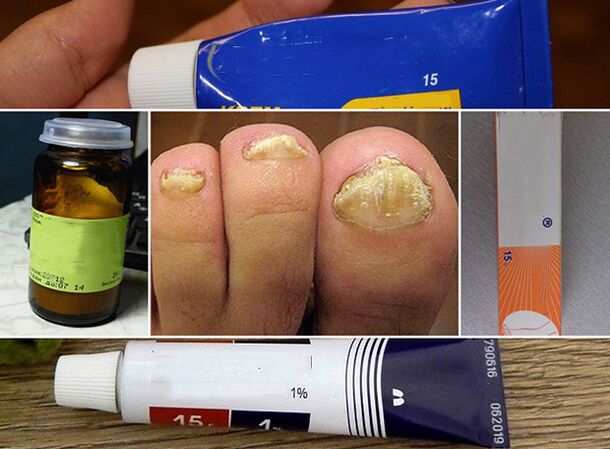
- Antifungal agents for internal and outdoor use;
- Antimicotics;
- corticosteroids;
- antihistamines;
- Polyvitamin complexes.
Important!
In the initial phase of disease, treatment can be carried out using alternative medicine recipes.Many of them help soon to solve problems, but in some cases they are able to cause an allergic reaction.
How is it dangerous to micoso on the soles?
If, after diagnosing mycosis, the patient refuses to treat or ignore the symptoms of the disease, his condition will worsen over time, and the symptoms will become more pronounced.In addition,Lack of treatment threatens the appearance of complications.Among them:
- spreading infection to large skin surfaces;
- Development of body hypersensitivity;
- Annex of secondary infection;
- Complications of related diseases.
Important!
Permanent physical and aesthetic discomfort can lead to psychological problems.
Can mycosis feet go to other parts of the body?
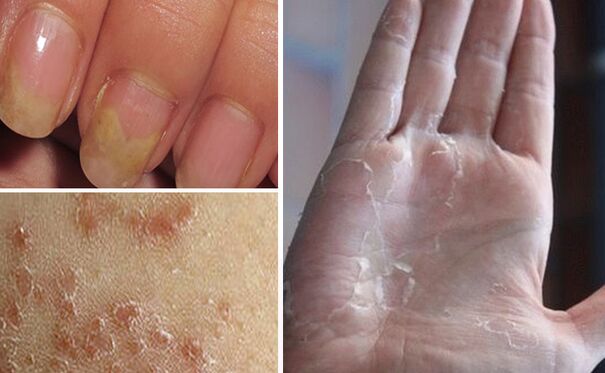
Fungal diseases do not constitute a certain danger to human life, but if no personal hygiene rules are noticed, the infection can be extended to other parts of the body, causing the look of great damage to the damage.
Patient may also notice the characteristic symptomatic manifestations of the patient in the later stages of the development of the pathological process, when they become on the skinThe rounded rash of pink shades are noticeableOr blisters with transparent facilities.
Disease prevention
In order to prevent Mykosi infection, it is not enough to turn off any contacts with possible fungal infection sources.In addition, the information is the least communications with disease brackets and their personal belongings, preventive measures should also be aimed at:
- compliance with personal hygiene;
- Treatment of chronic diseases;
- maintaining a healthy lifestyle;
- Strengthening immunity.
Fungus foot creates a danger not only for an infected person, but also for his immediate environment, so he discovered the first signs of mycosis, you needTake all possible mitigation measuresfrom the disease.
To avoid complications, it is important to contact a dermatologist in a timely manner for diagnostic measures and prescribing proper treatment using medications.

























